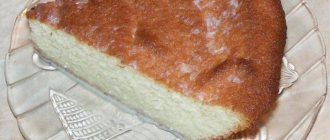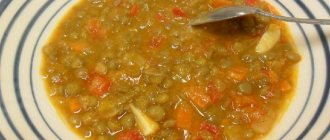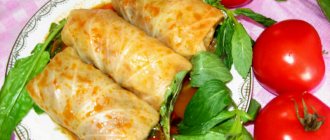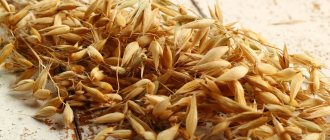Store shelves are lined with packages of dozens of varieties of rice [1]. It differs in shape, size, color and, accordingly, structure and taste. One of the varieties of aromatic rice is basmati with characteristic small oblong grains and a yellowish tint. Traditionally, basmati is produced in the countries of the Indian subcontinent, and its largest supplier is India.
What do you need to know about Indian basmati, are there any contraindications for the product, and what happens to the body with long-term consumption of rice?
general characteristics
Basmati is an aromatic rice variety. Jasmine and dozens of hybrid varieties also belong to this group. There is no single specific criterion by which rice could be classified as a basmati variety. The product is evaluated based on the totality of its properties and characteristics [2].
Content:
- general characteristics
- Brief historical background
- Useful properties of the product
- Chemical composition of the product
- Dangerous properties and possible harm of rice
- Use of rice in cooking
- Features of industrial production
- The problem of falsification
Authentic Indian Basmati is a harmonious combination of shape, size, intense aroma and texture. The length of the grain varies depending on the variety, but does not exceed 7 millimeters. The grain is thin, oblong, slightly curled at the end. Its shape is very similar to the Turkish dagger.
Indians prefer basmati over other varieties of rice for its taste and significant increase in volume when cooked.
During heat treatment, the volume of basmati doubles. This occurs due to an increase in the thickness and length of the grain. Keep this in mind when cooking so as not to overdo it with portion sizes. The boiled product has a sweetish taste and a subtle nutty aroma. If the rules for preparing the product have been followed correctly, the rice will be dry, crumbly and dense.
The taste characteristics of rice improve over time. It is believed that rice should ripen on its own within a year. The ripening period for higher varieties increases to 10 years.
Basmati rice: what is it?
Basmati is a type of rice with a unique taste and aroma that is reminiscent of popcorn. Its nutty smell is due to the presence of acetyl pyrroline in Basmati. Thanks to its taste, it works well as an independent dish.
Difference from regular rice
Unlike the rice we are used to, Indian rice is longer. The length of one grain is 8 mm. During cooking, they lengthen significantly without losing their shape. The photo clearly shows the elongated grains. Basmati color is initially yellowish. After sanding it becomes lighter and more transparent.
The main difference between regular rice and Indian rice is the taste and aroma. Basmati has the lowest glycemic index compared to other rice varieties: 56 versus 89 - it causes less increase in blood sugar.
This elite variety surpasses all others in the amount of vitamins and minerals.
Brief historical background
The term "basmati" is translated from Hindi as "fragrant". Historians say that rice cultivation in the Indian subcontinent began more than 3 thousand years ago. The first mention of the product is found in the poem “Heer Ranjha”. This is one of the popular Indian tragic works, which was written in 1766.
Initially, “basmati” was used to refer to absolutely all varieties of aromatic rice. Over time, this trend began to decline, and the term began to be applied only to a product of special quality.
Thanks to the light hand of Indian traders, the aromatic product was seen by the whole world. The spread began in the Middle East. The locals liked the basmati so much that they decided to resell it for additional profit. Gradually, basmati gained popularity and became the basis for Persian, Arabic and other Middle Eastern culinary traditions.
Today, rice is used in every gastronomic culture in the world. It is served with a variety of side dishes and combined with special herbs and spices, which favorably highlight its taste and aromatic composition. The dish is common among both street junk food and Michelin-starred restaurants, so every consumer will find a suitable variation to suit their own taste.
Pilaf with basmati rice
Basmati rice is ideal for pilaf.
The recipe is described using all the spices that are used in Central Asia.
Composition of ingredients
Product set:
- lamb – 450 g;
- Basmati – 450 g;
- large carrots – 2 pcs.;
- onions – 1.5 heads;
- vegetable oil – 150 ml;
- turmeric, ground black pepper, cumin, coriander (ground) - ½ tsp each;
- barabaris – 1 tsp;
- salt – 1.5 tsp;
- garlic – 1 large head;
- water – 0.75 l;
- ground red pepper - to taste.
What can be added and changed in the composition
Instead of lamb, which has a specific flavor, you can use beef, pork or chicken. Only then will the cooking time differ. Stores sell ready-made spice mixtures for pilaf. If the meat is too fatty, you should reduce the amount of vegetable oil.
Step-by-step cooking process
Cooking Guide:
- First of all, you need to prepare all the products so as not to be distracted while working. This will also help if the housewife has a low cutting speed. You should start with lamb, which must be rinsed with tap water, dried with napkins and removed excess fat, films and tendons. The presence of pieces with pits is acceptable.
- Vegetables must be peeled, washed and chopped: onions must be chopped into half rings, and carrots into strips.
- Next, you need to heat the oil in a cauldron to a boil and carefully add the meat, fry it over high heat until golden brown, stirring constantly.
- Now you should lower the flame and add vegetables. It is necessary to simmer under the lid for 5 minutes, until the carrots are soft.
- You need to pour in hot water, add all the spices, and bring the mixture to a boil.
- Rice must be washed thoroughly, changing the liquid, and placed on top of the lamb, without stirring under any circumstances.
- Stick an unpeeled but washed head of garlic in the middle, close and cook for 20 minutes.
Decoration and serving rules
Pilaf is never served right away. It needs to brew for at least 15 minutes. in a wrapped state. Now you can mix well and place on plates, but more often in Asia they place rice on a large dish first, and then meat and vegetables on top.
Useful properties of the product
Rice contains a lot of fiber. This is the rough part of the plant that is not digestible by the human body. It is the inability to digest fiber that determines its benefits and important role in the human diet. Basmati contains soluble fiber. After entering the body, it turns into a liquid gel that envelops the internal organs and improves their functionality.
What else is this substance useful for:
- reduces the concentration of glucose in the blood, prevents sudden surges in sugar after meals;
- regulates the level of “bad” cholesterol, thereby reducing the risk of developing heart and vascular diseases;
- improves bowel function and solves problems with irregular or painful stools;
- promotes long-term saturation and the formation of powerful energy potential, which protects against overeating and helps to lose weight;
- harmonizes internal microflora and improves skin condition;
- protects the body from the development of breast cancer and intestinal cancer;
- nourishes the internal microbiome, which contributes to high-quality human life.
The content of vital amino acids in basmati is several times higher than in other varieties of rice. This product is a leader in the concentration of iron, phosphorus, potassium and vitamins. Moreover, basmati contains a minimal amount of sodium, which helps maintain a normal potassium-sodium balance.
A high-quality product gently envelops the stomach, is easily digestible and does not create a significant burden on the digestive tract. Another benefit is its lower glycemic index [3]. After a serving of rice, the product is slowly released into the blood, and the sugar level remains normal. This GI provides long-term satiety, reduced cravings for sweets and a feeling of lightness until the next meal.
Health Benefits of Basmati Rice
Basmati rice may be associated with several health benefits.
Low arsenic levels
Compared to other types of rice, basmati rice tends to have less arsenic, a heavy metal that can harm your health and potentially increase your risk of diabetes, heart problems and some types of cancer ().
Arsenic tends to accumulate more in rice than in other grains, which may be especially true for those who regularly eat rice ().
However, some studies have shown that basmati rice from India, Pakistan or the US has some of the lowest levels of arsenic compared to other rice varieties ().
Additionally, it should be noted that brown rice varieties tend to contain more arsenic than white rice because arsenic accumulates in the hard outer layer of the bran.
Can be enriched
White basmati rice is often fortified, meaning that certain nutrients are added during processing to help increase the nutritional value.
This can help you meet your needs for various important vitamins and minerals.
In particular, rice and other grains are often fortified with iron and B vitamins such as folic acid, thiamine and niacin ().
Some types are whole grains
Brown basmati rice is considered a whole grain, meaning it contains all three parts of the kernel - the germ, bran and endosperm.
Whole grains are associated with many health benefits. For example, an analysis of 45 studies linked consumption of whole grains to a lower risk of heart disease, cancer, and premature death ().
Another review linked regular consumption of whole grains, including brown rice, to a lower risk of developing type 2 diabetes ().
What's more, an 8-week study of 80 people found that replacing refined grains with whole grains reduced levels of inflammatory markers ().
Chemical composition of the product
Energy value (per 100 grams) [4]
| Calorie content | 370 kcal |
| Squirrels | 7.94 g |
| Fats | 2.92 g |
| Carbohydrates | 77.24 g |
| Alimentary fiber | 3.5 g |
| Water | 10.37 g |
Vitamin composition (in milligrams per 100 grams)
| Thiamine (B1) | 0,401 |
| Riboflavin (B2) | 0,093 |
| Pantothenic acid (B5) | 1,493 |
| Pyridoxine (B6) | 0,509 |
| Folic acid (B9) | 0,02 |
| Tocopherol (E) | 1,2 |
| Phylloquinone (K) | 0,0019 |
Nutrient composition (in milligrams per 100 grams)
| Calcium (Ca) | 23 |
| Magnesium (Mg) | 143 |
| Sodium (Na) | 7 |
| Potassium (K) | 223 |
| Phosphorus (P) | 333 |
| Iron (Fe) | 1,47 |
| Zinc (Zn) | 2,02 |
| Copper (Cu) | 0,277 |
| Manganese (Mn) | 3,743 |
Nutritional value, composition and calorie content of basmati rice
How to cook Uzbek pilaf in a cauldron at home according to classic recipes
While the exact nutrient composition varies depending on the specific type of basmati, each serving is typically high in carbohydrates and calories, as well as micronutrients such as folate, thiamine and selenium.
One 160g serving of cooked white basmati rice contains ():
- Calories: 210 kcal
- Protein: 4.4 grams
- Fat: 0.5 grams
- Carbohydrates: 45.6 grams
- Fiber: 0.7 grams
- Sodium: 399 mg
- Folate: 24% of recommended daily intake (RDI)
- Thiamine: 22% of RDI
- Selenium: 22% of RDI
- Niacin: 15% of RDI
- Copper: 12% of RDI
- Iron: 11% of RDI
- Vitamin B6: 9% of RDI
- Zinc: 7% of RDI
- Phosphorus: 6% of RDI
- Magnesium: 5% of RDI
In comparison, brown basmati rice contains slightly more calories, carbohydrates and fiber. It also provides the human body with large amounts of magnesium, vitamin E, zinc, potassium and phosphorus ().
Dangerous properties and possible harm of rice
The high amylase content in rice can lead to intestinal dysfunction and colic. Moreover, nutritionists say that eating rice is one of the causes of obesity. Do not overuse basmati to avoid these unpleasant consequences.
People with individual intolerance and children under 3 years of age should completely avoid the product.
Scientists have found a direct link between rice consumption and an increased risk of diabetes [5]. Nutritionists still cannot come to a consensus regarding the benefits and harms of this product. Some consider rice a safe starch, while others consider it a source of empty carbohydrates.
For 20 years, scientists conducted a study in which more than 350,000 subjects took part. As a result, it became possible to draw a parallel between the consumption of basmati and the development of diabetes. The risk level increases by 1.5%, which is a very significant indicator.
How to protect yourself? Scientists recommend eating more brown rice and combining it with the usual white rice. You need to add at least 100 grams of vegetables to each dish to balance your diet and get the required amount of nutrients. The main thing is that the daily BJU is balanced, and in the usual rhythm of life there is time for your favorite physical activity. Then the risk of disease is reduced to a minimum.
Pilaf with basmati rice
- Cooking time: 1 hour 30 minutes.
- Number of servings: 4 persons.
- Calorie content of the dish: 328 kcal.
- Purpose: for lunch.
- Cuisine: Pakistani.
- Difficulty of preparation: medium.
This version of crumbly pilaf is known as Pakistani pulao: here you need to use 2 types of rice grains and 7 spices. Traditionally, lamb is added to pilaf with basmati rice, but if desired, it can be replaced with any meat or even fish - in any case it will be delicious.
Ingredients:
- Basmati Gold (Mistral) – 200 g;
- onion – 1 pc.;
- brown rice (Indica Brown) – 100 g;
- oil (vegetable) – 2 tbsp. l.;
- meat – 400 g;
- carrots – 2 pcs.;
- garlic – 2 cloves;
- petiole celery – 1 pc.;
- water – 400 ml;
- parsley – 0.5 bunch;
- raisins – 30 g;
- nutmeg – 0.15 tsp;
- coriander – 0.25 tsp;
- paprika – 0.5 tsp;
- black pepper – 0.25 tsp;
- cardamom – 0.5 tsp;
- cumin – 0.25 tsp;
- cinnamon – 0.25 tsp;
- almonds – 50 g.
Cooking method:
- Heat the vegetable oil, pour it into a frying pan with high sides, and fry small onion cubes.
- Add carrots, grated in large sections, followed by crushed garlic.
- Add small pieces of meat to the soft vegetables and fry everything together until golden brown.
- Pour brown rice into a bowl, add water to the ingredients, bring the liquid to a boil, then reduce the heat and leave the dish to cook for 25 minutes.
- Add white basmati and all the necessary spices. Mix the ingredients and simmer for another 25 minutes.
- Remove the container from the stove, add raisins and peeled almonds. Let it brew a little longer.
Use of rice in cooking
Basmati has a specific spicy aroma and nutty flavor palette. This is explained by the high content of the chemical compound 2-acetyl-1-pyrroline. A similar compound is found in pandan leaves, which are dried and used as a spice. The same cyclic compound is found in cheese, fruits and most cereals. On an industrial scale, it is used to impart a specific aroma to baked goods.
Basmati grains contain a minimal concentration of gluten (gluten), due to which the rice grains are easily washed and separated from each other without effort.
The product can be subjected to all types of heat treatment, but steam is considered the most successful in terms of taste and benefits.
How to cook the product correctly
Pour the rice into a container and rinse 3 to 7 times (pay attention to the degree of turbidity and the shade of the water). If you cook unwashed rice, the result will be a sticky texture and an unnatural taste.
Prepare a saucepan with a thick bottom, pour water into it at the rate of 2 cups of liquid per 1 cup of rice. Place the washed basmati into boiling water. You can first add salt and your favorite spices to the liquid.
Set the heat to maximum and cook the rice for 4 minutes. Then reduce the heat to medium and cook for another 4 minutes. At the last stage, reduce the heat to low and cook the cereal for another 4 minutes.
Remove the finished basmati from the stove, cover with a lid and leave for at least 10 minutes. Rice must independently “reach” the desired taste and structure. Before serving, thoroughly stir the contents of the pan. Basmati should be combined with other components of the dish immediately before serving.
Pilaf with basmati rice
- Cooking time: 1 hour 30 minutes.
- Number of servings: 4 persons.
- Calorie content of the dish: 328 kcal.
- Purpose: for lunch.
- Cuisine: Pakistani.
- Difficulty of preparation: medium.
This version of crumbly pilaf is known as Pakistani pulao: here you need to use 2 types of rice grains and 7 spices. Traditionally, lamb is added to pilaf with basmati rice, but if desired, it can be replaced with any meat or even fish - in any case it will be delicious.
Ingredients:
- Basmati Gold (Mistral) – 200 g;
- onion – 1 pc.;
- brown rice (Indica Brown) – 100 g;
- oil (vegetable) – 2 tbsp. l.;
- meat – 400 g;
- carrots – 2 pcs.;
- garlic – 2 cloves;
- petiole celery – 1 pc.;
- water – 400 ml;
- parsley – 0.5 bunch;
- raisins – 30 g;
- nutmeg – 0.15 tsp;
- coriander – 0.25 tsp;
- paprika – 0.5 tsp;
- black pepper – 0.25 tsp;
- cardamom – 0.5 tsp;
- cumin – 0.25 tsp;
- cinnamon – 0.25 tsp;
- almonds – 50 g.
Cooking method:
- Heat the vegetable oil, pour it into a frying pan with high sides, and fry small onion cubes.
- Add carrots, grated in large sections, followed by crushed garlic.
- Add small pieces of meat to the soft vegetables and fry everything together until golden brown.
- Pour brown rice into a bowl, add water to the ingredients, bring the liquid to a boil, then reduce the heat and leave the dish to cook for 25 minutes.
- Add white basmati and all the necessary spices. Mix the ingredients and simmer for another 25 minutes.
- Remove the container from the stove, add raisins and peeled almonds. Let it brew a little longer.
Features of industrial production
Traditional producers and exporters of basmati are India and Pakistan [6]. The total volume of harvested crops in both countries amounts to tens of millions of tons. Outside of Pakistan and India, there are only local rice farms that work with private entrepreneurs, filling a minimal percentage of the world's turnover.
Producing high-quality traditional basmati requires a lot of effort and material expenditure. Moreover, this particular rice is considered the most popular among consumers, so the efforts of large concerns are paying off. The cost of basmati is much higher than any other aromatic rice, but its nutritional/taste properties are also different.
Traditional basmati varieties produce minimal yields. Most crops are subject to attacks by pests and diseases, so many hybrid varieties with the most favorable parameters have been created [7]. To get a high yield from a traditional variety, you will have to strictly adhere to the sowing/transplanting dates and carefully select the region where the crop is grown. The culinary properties of the product depend on:
- method of transplantation;
- density of planted plants;
- the period of disembarkation and transplantation;
- storage conditions for collected grain;
- harvest time interval.
Successful cultivation of the crop is possible only under certain conditions. During the growth period, the plant requires high humidity (80%) and temperatures ranging from 25 to 35°C. Additionally, you need to provide rice with irrigation, drainage and neutral soil. Moderate humidity, warm weather and little wind are the key to a bountiful harvest that will delight you with a pleasant taste and aroma.
Best materials of the month
- Coronaviruses: SARS-CoV-2 (COVID-19)
- Antibiotics for the prevention and treatment of COVID-19: how effective are they?
- The most common "office" diseases
- Does vodka kill coronavirus?
- How to stay alive on our roads?
Rice is a light-sensitive crop. The formation of flowers and ripening of rice begins in the short daylight stage. This does not always have a positive effect on the quality of the crop and the nutritional properties of the cereal. To reduce photosensitivity, agronomists have developed several hybrid varieties of basmati, which are used in equal quantities with traditional ones.
By the end of the twentieth century, three hybrid varieties entered the market, which were not inferior to real basmati in taste and quality. The yield of these varieties was 4.5 tons per hectare of land versus 2.5 tons. High yields, resistance to diseases/pests and identical taste won over producers and consumers, and hybrid varieties reached the peak of popularity [8]. Due to them, it was possible to slightly reduce the cost of the finished product and increase sales volumes.
Basmati rice
Basmati rice is an elite variety of long grain rice native to India. The name Basmati is translated from Hindi as “fragrant” or “full of taste”. And it’s true, the exquisite aroma is difficult to compare or describe with anything. Some people detect light nutty notes, while others smell the aroma of a sun-warmed forest.
In India, this rice is treated with special respect and is called the grain of the gods. This is due to the fact that the harvest season coincides with a series of religious holidays. Therefore, Basmati rice is mentioned even in thousand-year-old holy books and chronicles.
Basmati rice is different from regular rice
The most important difference is the delicate aroma and slightly creamy taste, formed by the unique growing region. As in winemaking, the cultivation of Basmati uses the concept of “terroir” - a set of climatic features and terrain. Basmati is grown at the foot of the Himalayas, where meltwater from glaciers and the purest ecology help produce rice that can be compared to a delicacy.
The graceful shape of Basmati resembles needles. During cooking, grains of rice can almost double their length. The color has a pleasant golden hue, which remains even in the finished dish. When cooking, the grains do not stick together, so the rice turns out crumbly and fluffy.
Another feature of Basmati is its low glycemic index.
This is very important for those who monitor their sugar levels and prefer dietary nutrition.
How to cook Basmati rice
Thanks to the convenient cooking bags, preparing MAKFA Basmati will not be a hassle. Simply put the bag in boiling water and set the timer. Cooking time: 15 minutes.
Most often, Basmati is prepared as a side dish or an independent dish. Its taste and aroma are perfectly revealed in soups. And it will add a unique “zest” to pies and pies. The special friability of Basmati is perfect for pilaf and for preparing various wok dishes with the addition of vegetables and oriental hot spices.
To enhance the nutty flavor of this rice, you can safely add black pepper, cumin, lemon juice and any fresh herbs.











